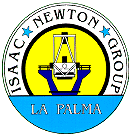| Telephone:
+34 922 425400
Fax: +34 922 425401 Web: http://www.ing.iac.es/ |
 |
Apartado de
Correos, 321
38700 Santa Cruz de La Palma Canary Islands; SPAIN |
| Telephone:
+34 922 425400
Fax: +34 922 425401 Web: http://www.ing.iac.es/ |
 |
Apartado de
Correos, 321
38700 Santa Cruz de La Palma Canary Islands; SPAIN |
|
The Isaac Newton Group of Telescopes is an establishment of the Particle Physics and Astronomy Research Council (PPARC) of the United Kingdom and the Netherlands Organisation for Scientific Research (NWO) |
|
|
| Press Release ING
2/2001
Date: Wednesday 11 July 2001 Embargo: For immediate release Other available formats: PDF | TXT Mirror in UK: http://www.ast.cam.ac.uk/ING/PR/press/ing22001.html S-CAM, THE WORLD'S MOST ADVANCED OPTICAL CAMERA, CAPTURES ECLIPSE OF BINARY STAR
A totally new type of optical detector has been used on the William Herschel
Telescope to directly
measure intensity and colour changes in a faint, rapidly variable
binary star system, UZ Fornacis,
for the first time. A team from the Space Science Department of the
European Space Agency's
Research and Technology Centre in the Netherlands (ESA/ESTEC), who have
developed the S-Cam camera, were joined by astronomers from the Mullard
Space Science Laboratory (MSSL) in the UK to exploit this advanced instrument.
With conventional optical CCD detectors, very rapid changes in light
intensity cannot be measured. Furthermore, the energy or wavelength
of the arriving photons can only be measured by introducing a filter or
spectrograph into the optical light path, degrading the efficiency. With
the new instrument, advanced detector elements based on
superconducting technology register the arrival of each photon
individually, and measure its energy and wavelength directly.
"This cryogenic
detector is very efficient, very sensitive, and very fast; and there
is no dark current or readout noise", explains Dr. Anthony Peacock, who has
led the development of the detector technology from ESA's Astrophysics
Division. The instrument, built by an ESA technical team led by Nicola
Rando, is cooled to below one degree kelvin to minimise all
possible noise, resulting in an almost perfect detector performance.
Larger and larger telescopes are being built on the ground and in space to
study fainter and more distant objects, but more efficient detectors
are paramount to astronomers' progress in understanding.
"We have a very powerful instrument for looking at faint astronomical
sources which vary rapidly, for example pulsars or binary star systems. It
is of particular interest when the light changes its energy
distribution, or colour, at the same time", said Dr. Michael Perryman, who has led
this astronomical investigation.
In the particular binary star system studied, one of the two stars is a so-called
white dwarf, a star in
an advanced state of stellar evolution that collapses slowly under
its own gravity. This white dwarf tears
gas from the surface of its nearby companion, which is then engulfed
by the white dwarf's powerful gravitational field. The material is
channelled down highly intense magnetic field lines onto the surface
of the white dwarf, where it emits prolific amounts of optical, ultraviolet and X-ray radiation as it cools.
Many clues are contained in the very
short interval of time in which the intense light emitted by the
infalling material is eclipsed by its larger but fainter companion.
The results show that the diameter of the accretion spot, where
material hits the white dwarf surface, is less than about 100 km.
Dr. Mark Cropper, from the Mullard Space Science Laboratory, has been studying this type of binary system,
known as a magnetic cataclysmic variable, for more than a decade.
"This new detector allows us to look at changes in the light from the
system as it changes over small fractions of a second. And this is the
first time we have been able to study the rapid colour changes which
occur at the same time."
The results of the observations, performed by an ESA technical team in support of the ESA/MSSL science team, were made
at the William Herschel Telescope in December 1999, and are reported today in the scientific
journal Monthly Notices of the Royal Astronomical Society.
ESA scientists Dr. Michael Perryman, Dr. Clare Foden and Dr. Anthony Peacock
published the theoretical ideas underlying the new detector in 1993,
the first instrument able to detect the energy of optical photons
directly. Dr. Anthony Peacock and Dr. Peter Verhoeve at ESTEC reported the first
detection of optical photons using this technology in 1996. S-Cam, the instrument making use of these
principles and developed by the same research team, was commissioned at the William
Herschel Telescope in February 1999 (see ING Press Release
ING 0/99) and its scientific exploitation has been supported by Dr. Fabio
Favata and Dr. Alastair Reynolds.
The Isaac Newton Group of Telescopes
(ING) is an establishment of the Particle Physics and Astronomy Research
Council (PPARC) of the United Kingdom and the Netherlands Organisation for
Scientific Research (NWO). The ING operates the
4.2 metre William Herschel Telescope, the 2.5 metre Isaac Newton Telescope,
and the 1.0 metre Jacobus Kapteyn Telescope. The telescopes are located
in the Spanish Roque de Los Muchachos Observatory on La Palma which
is operated by the Instituto de Astrofísica de Canarias (IAC).
PICTURES
FOR FURTHER INFORMATION PLEASE CONTACT:
Dr. Michael Perryman
Dr. Mark Cropper Mr. Javier Méndez
More information on the web:
"High-Speed Energy-Resolved STJ Photometry of the Eclipsing Binary UZ
For" paper on arXiv.org electronic archive.
The
STJ page at ESA Astrophysics includes details of the ESA
superconductor detector programme. S-Cam 2 is the second prototype
camera. More information on S-Cam 2 can be found here.
Two articles on S-Cam and S-Cam 2 have been published in the ING
Newsletter: "Super Cool
Technology" and "S-Cam Update -
Novel Capabilities for Resolving Old Problems!".
More information on
cataclysmic variable stars can be found at the web
pages of the visitor centre of the Astrophysics Group
of the Mullard Space Science Laboratory.
More information on the Isaac Newton Group
of Telescopes:
|